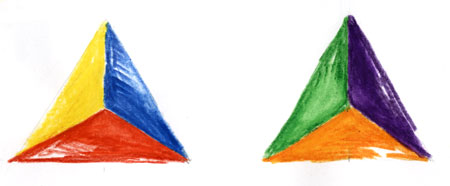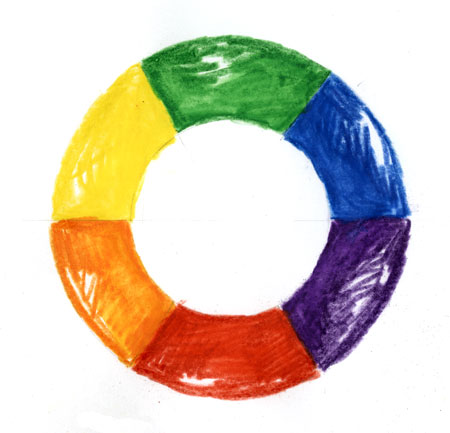« Things that don’t mix | Main | distractions »
April 08, 2005
The plasticine effect.
It’s not strictly true that flake white and transparent red oxide don’t mix [see below: "things that don't mix"], they do mix but they make the palette a revolting pinky brown and generally unpleasant.
Mixing colours is a tricky business, a business where the axiom Less is More is apposite. There are only, basically, three colours – okay, okay, Winsor & Newton have 100 colours, Dulux Matchmaker can mix you 16,000 different colours and Epson say they produce three and a half million with their top of the range printers BUT these are just mixtures of the three basic colours. The colours are RED, BLUE & YELLOW. [We’ll talk about black and white at a later date]
Red, Blue and Yellow are the PRIMARY COLOURS, mix these guys in pairs and you get ORANGE, GREEN & PURPLE: the SECONDARY COLOURS.

Put all these colours in a circle: RED, PURPLE, BLUE, GREEN, YELLOW, ORANGE, and BINGO! you’ve got yourself a colour wheel.

Now we get to the tricky bit: The Plasticine Effect. If you mix all three primary colours you get BROWN. Not pleasant-warm-new-conker brown, or deep-dark-mysterious-nearly-black brown, but yucky-sludgy-just-come-out-of-the-wrong-end-of-a-cow brown. Shitty brown in simple terms. The colour your Plasticine always ended up. So never mix three colours together, in similar quantities, as they will always tend towards the more unpleasant variety of brown.
The colours opposite each other on the colour wheel are called COMPLIMENTARY COLOURS and are party to their own set of rules, not a few of which crop up in our daily lives with sayings like “Red and green should never be seen”. Basically complimentary colours vibrate when put next to each other. Much used by the Op Artists. They are useful for dramatic effects in painting.
Complimentary colours are made up of all three primaries, in that they are usually a primary and a secondary, therefore they contain all three primary colours so: never mix complimentary colours together or you’ll get a turd on your palette.
A simple rule: mix two colours then ‘break’ it with a third. That is: use a good dollop of two colours, then a just a touch of a third. This way leads to the many colours we see around us.
Of course in American there are NO colours – they’re all colors, but their cause is not ours.
Posted by john at April 8, 2005 09:21 AM
Trackback Pings
TrackBack URL for this entry:
http://www.deletetheweb.com/unstuck/mt/mt-tb.cgi/245